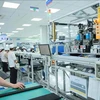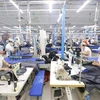Agriculture Minister Cao Duc Phat is scheduled to deliver a keynote speech at the World Economic Forum (WEF) 2014 in Davos, Switzerland, this week, radio The Voice of Vietnam reported on January 21.
A Food and Agriculture Organisation (FAO) report shows agricultural production needs to be boosted to feed the increasing global population estimated at nearly 10 billion by 2050.
Rural workforce is downsizing as a consequence of rapid urbanisation, posing a great threat to agriculture. In addition, the global food system is beset by serious challenges and risks: more volatile production and prices, high hunger and poverty levels, and unsustainable farming practices.
The 2010 World Economic Forum on East Asia in Ho Chi Minh City put forward the initiative “A New Vision for Agriculture”, aiming to build a new farming model that yields high output and improve farmer livelihoods.
The initiative has been undertaken in Vietnam, Indonesia and Myanmar (in Asia) in partnership with 250 stakeholders.
Vietnam lives off agricultural production, with rice, coffee, rubber, tea, pepper, fruits, aquatic and husbandry products keeping key positions. In 2012, agriculture made up 21.5 percent of the country’s GDP, 20.8 percent of total export earnings, and nearly 50 percent of the workforce.
However, the sector is faced with challenges arising from climate change, excessive use of water resources, and high levels of greenhouse emissions.
A European Chamber of Commerce (EuroCham) white book reveals the ratio of agriculture in the GDP dropped from 46.3 percent in 1988 to 22 percent in 2012, and the rural workforce proportion also fell from 67 percent in 1997 to 47.5 percent in 2011.
In his 2014 New Year message, Prime Minister Nguyen Tan Dung raised concerns about the agricultural sector’s weaknesses, including an annual decreasing growth rate, uncoordinated links, and low productivity in the context of global fierce competition.
He stressed the need to accelerate agriculture restructuring and technological application, with farmers forming the core.
The Government has approved a 10-year agriculture development strategy, encouraging the engagement of private businesses.
The agricultural sector has established six working groups on seafood, coffee, fruit and vegetables, tea, soybean and maize, as well as support solutions, to realise the WEF initiative.
Vietnam has gained encouraging results after undertaking the initiative for the past three years. Coffee yield rose 10 percent, consumed water amount decreased 14 percent, gas emissions dropped 54 percent, and tea export output rose threefold.
In the address, the PM affirmed the Government will introduce policies to increase the application of scientific and technological advances, especially biological and information technology, in agricultural production and management, helping accelerate agricultural industrialisation and rural modernisation.
New cooperation models will be established between farmers and businesses to create value chains, from production to consumption, and attract more investment in to agricultural production, trading and services.
A Government decree, effective as of February 10, 2014, will encourage businesses to invest in agricultural production and rural development. Investors will enjoy many incentives including land rent reductions or exemptions.-VNA
A Food and Agriculture Organisation (FAO) report shows agricultural production needs to be boosted to feed the increasing global population estimated at nearly 10 billion by 2050.
Rural workforce is downsizing as a consequence of rapid urbanisation, posing a great threat to agriculture. In addition, the global food system is beset by serious challenges and risks: more volatile production and prices, high hunger and poverty levels, and unsustainable farming practices.
The 2010 World Economic Forum on East Asia in Ho Chi Minh City put forward the initiative “A New Vision for Agriculture”, aiming to build a new farming model that yields high output and improve farmer livelihoods.
The initiative has been undertaken in Vietnam, Indonesia and Myanmar (in Asia) in partnership with 250 stakeholders.
Vietnam lives off agricultural production, with rice, coffee, rubber, tea, pepper, fruits, aquatic and husbandry products keeping key positions. In 2012, agriculture made up 21.5 percent of the country’s GDP, 20.8 percent of total export earnings, and nearly 50 percent of the workforce.
However, the sector is faced with challenges arising from climate change, excessive use of water resources, and high levels of greenhouse emissions.
A European Chamber of Commerce (EuroCham) white book reveals the ratio of agriculture in the GDP dropped from 46.3 percent in 1988 to 22 percent in 2012, and the rural workforce proportion also fell from 67 percent in 1997 to 47.5 percent in 2011.
In his 2014 New Year message, Prime Minister Nguyen Tan Dung raised concerns about the agricultural sector’s weaknesses, including an annual decreasing growth rate, uncoordinated links, and low productivity in the context of global fierce competition.
He stressed the need to accelerate agriculture restructuring and technological application, with farmers forming the core.
The Government has approved a 10-year agriculture development strategy, encouraging the engagement of private businesses.
The agricultural sector has established six working groups on seafood, coffee, fruit and vegetables, tea, soybean and maize, as well as support solutions, to realise the WEF initiative.
Vietnam has gained encouraging results after undertaking the initiative for the past three years. Coffee yield rose 10 percent, consumed water amount decreased 14 percent, gas emissions dropped 54 percent, and tea export output rose threefold.
In the address, the PM affirmed the Government will introduce policies to increase the application of scientific and technological advances, especially biological and information technology, in agricultural production and management, helping accelerate agricultural industrialisation and rural modernisation.
New cooperation models will be established between farmers and businesses to create value chains, from production to consumption, and attract more investment in to agricultural production, trading and services.
A Government decree, effective as of February 10, 2014, will encourage businesses to invest in agricultural production and rural development. Investors will enjoy many incentives including land rent reductions or exemptions.-VNA



















